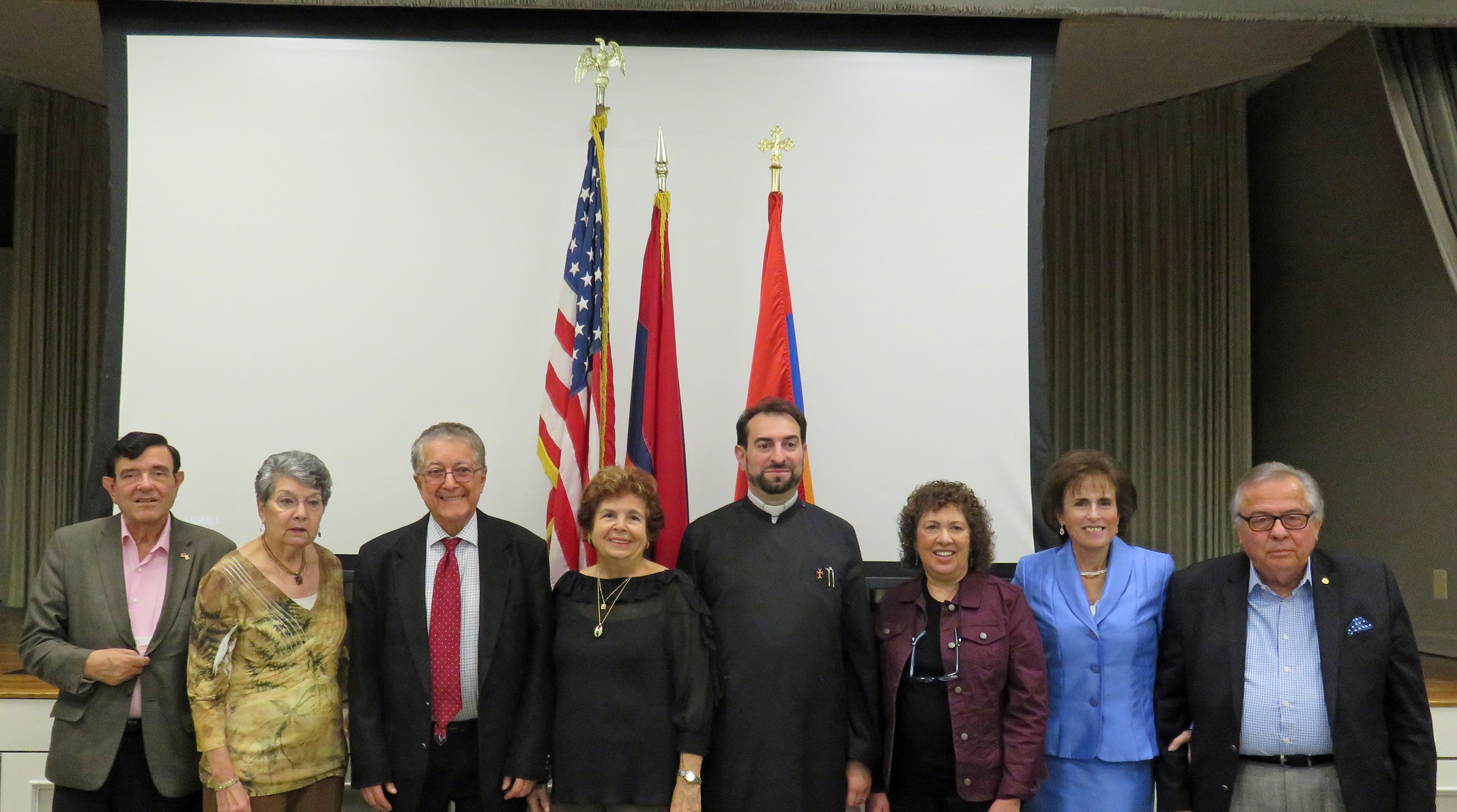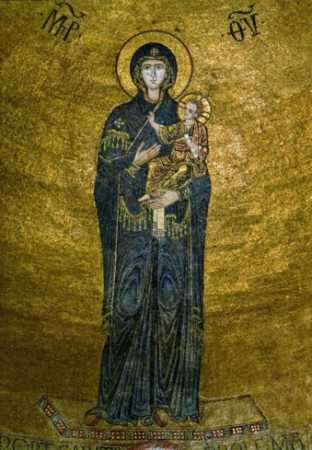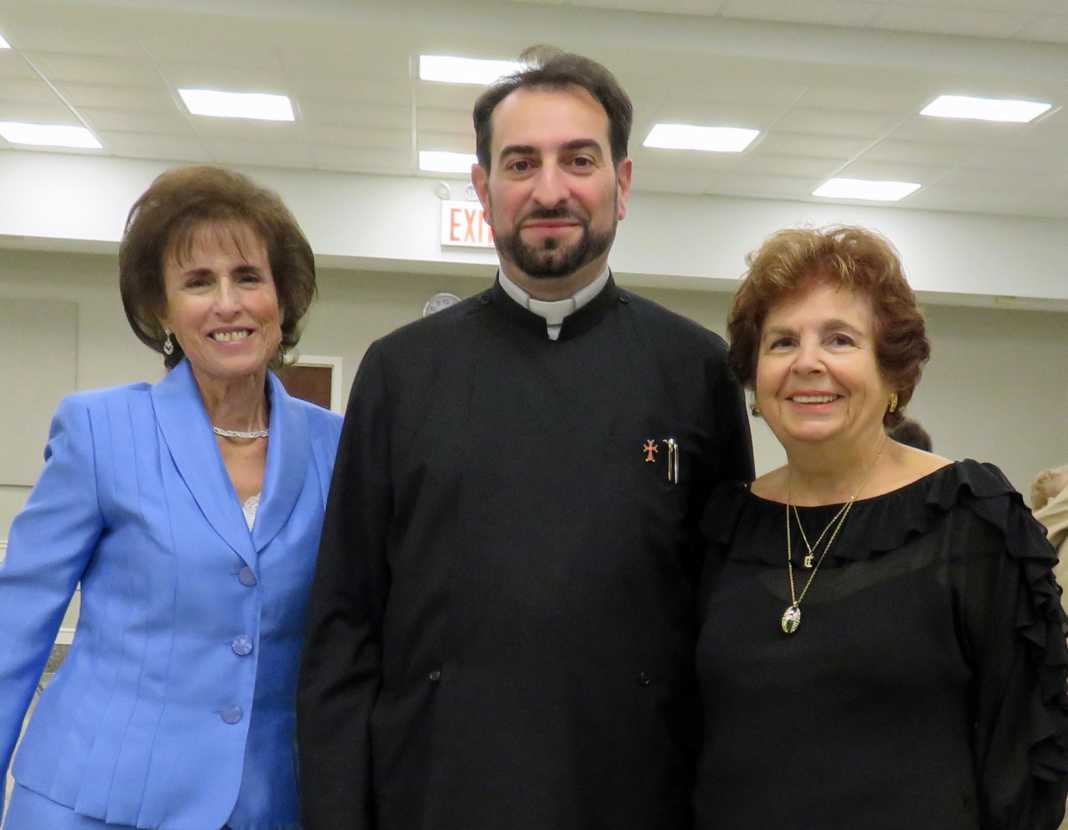“It is the mark of a bad general when all is peaceful, to incite his neighbors to war intentionally-for peace is the objective of all wars.” The Alexiad Book XII.
The Armenian Church of the Holy Martyrs Woman’s Guild, The Armenian Church of the Holy Martyrs Women’s Guild held a lecture on Wednesday afternoon, October 30th, “Presenting an In-Depth Look into Anna Comnena: Byzantine Princess and Historian with Armenian Roots.” The speaker, Catherine Tsounis, gave a digital program on the world of Anna Comnena. Slides showing Byzantine architecture, iconography and mosaics in Sicily, Ravenna and Venice, Italy explained Anna Comnena’s world of the 1100’s A.D. in the Eastern Roman world known as the Byzantine Empire. The event was held in the church hall located at 209-15 Horace Harding Expressway, Bayside, NY. Rev. Fr. Abraham Malkhasyan is the pastor. Mrs. Carol Anastasian was the Lecture Chairperson, assisted by the Executive Board of the Women’s Guild. Over fifty persons attended. Prominent persons included: Mrs. Angela Vournas, Artist/Educator: President Chris Vournas of “Geros Tou Morea” chapter of the Pan Arcadian Federation of America, Principal Seta Megherian of the Holy Martyrs Day School, Mardo Anastasian, Businessman/Scholar and prominent members of the New York Community
“Anna Comnena was a Byzantine princess, first known woman historian and perhaps the best-educated woman in the Mediterranean world between the 5th and 15th centuries,” said Rev. Fr. Malkhasyan in the church publication. “Professor Catherine Tsounis has a Master of Arts Degree in Byzantine History from Queens College. She is a journalist, educator, writer of Greek Language and Culture. A photojournalist from 1974 on the internet, magazine and newspaper mediums, Professor Tsounis was inducted into “Who’s Who Among America’s Teachers” in 2002 and 2005. She had an outstanding contribution to NYC and the Greek American community. She wrote many books of “Greek-American Experience” and is active at St. Nicholas Greek Orthodox Church, Flushing, N.Y.”

Ms. Tsounis opened the program with the question “what was the Byzantine Empire?
It was a multi-ethnic, multi-racial society without Nationalism. Everyone was a Roman with a secular education of classics, math, science. The Greek/Roman civilization was based on Eastern Christian religion. It was termed Byzantine during the Renaissance by a German scholar to show it was inferior to the West. The Byzantine Empire is the only empire in history to last over 1100 years. The survival of the culture of the successors of Alexander and of Rome must also be attributed to the unrecognized Hellenized Armenians. The Armenians embraced the Empire’s Greek language, culture and religion becoming Byzantines. They helped saved Western Civilization for over five hundred years as Emperors, military leaders, and soldiers, protecting Western Europe from barbarian invasions. They intermarried with Roman-Byzantine Aristocracy. Armenians assimilated into a Christian melting pot. Anna Comnena is descended from the Armenian General Manuel Comnenas.”
Educator Tsounis said “before I begin about the personal life of Anna Comnena, I would like to mention overlooked facts about Byzantine women, that included Byzantine Armenians.

Byzantine women were the forerunners of modern women. They had rights and privileges unknown in other societies. They took an important part in the fields of politics, government, medicine, and education. The Byzantine empresses, that Anna Comnena was trained to become, set the tone for the empire, having a significant impact on women within their empire and future generations. Byzantine empresses defined the rights and privileges of all women of all ages. What happened? The Western Roman Empire, Western Europe, centered in Rome, eradicated women’s lawful rights. They abolished women’s laws and pushed women into slavery with no rights. The West expanded into new lands and carried their misguided women’s policies with them that reduced and marginalized women.1 Anna Comnena, her Mother Irene Ducas, grandmother Anna Dalassena, ruled the Byzantine Empire, while the emperor Alexius fought wars.

The speaker described “Anna was born in the porphyry birth chamber of royal children. First born child of Emperor Alexius Comnenos and Empress Irene Ducas. She was crowned a future empress as a baby in the cradle. They saluted her as heir apparent to the throne. As a baby, she became engaged to former Empress Maria of Alania’s son, Constantine Ducas. She was born to the purple and dreamed when she would be Empress and sit on the throne. She was raised by her future Mother in law Maria of Alania, as was the Byzantine custom. When Constantine died, she returned to the care of her parents, with great unhappiness. She was in a deeply religious traditional court. No scandal or amoral behavior.
In the 11th century, Anna was given the best religious and secular education with the best teachers. She learned Greek literature, Aristotle and Plato’s philosophies, Mathematics, Rhetoric, Astronomy, Geography, Science and Religion. Strong women who ruled the empire were her role models. She had a major catastrophe in her life. At eight years old, her misfortunes began in 1091, with the birth of her brother John II.
He was designated as the heir to the throne. The great misfortune of her life. At 14 years old in 1097, she married an aristocrat Nicephorus Bryennius. She spent the rest of her life plotting to put him on the throne as emperor. Power, the throne was all she dreamed of.”

The speaker asked the question “What did Anna Comnena look like? She looked like her father Alexius 1 whose grandfather was an Armenian general. Medium height, very dark, beautiful lively, intelligent eyes, with a superior intellect. She was honest, energetic and ambitious, with a love for literature. She was a dominant political and literary figure in the Byzantine era. A false notion created by Western historians is that women lived in a harem. They were Christians. Under few governments have women like Anna Comnena had a better position, played an important part or had a greater influence on politics or government than under the Byzantine Empire.
Anna Comnena, her husband Nicephorus Bryennius and her mother Empress Irene Ducas, ruled behind the scenes as Emperor Alexius was involved in the reconquest of Byzantine Western Armenia and Anatolia from the Turks. Anna had her own money, political opinions and complete freedom. She oversaw an orphanage and hospital that had the capacity of 10,000 patients. She taught medicine and became an expert on gout.2
After her brother was on the throne, Comnena and her mother plotted to overthrow him and to replace him with Anna’s husband. But Bryennius apparently refused to take part in the plot. Their plans were discovered and thwarted, Anna and her husband had to leave the court. Anna lost her estates but were later restored to her.

When Comnena’s husband died in 1137, she and her mother were sent to live in the convent of Kecharitomene, (Our Lady of Grace) which Irene had founded. The convent was devoted to learning, and there, at age 55, Comnena began serious work on the book for which she will long be remembered.3
In her works, Anna directed most of her contempt toward the crusaders from the West. Her father had sent the first envoys to the West, to Pope Urban I, asking for help in halting the Turkish raids which had left the southern and eastern borders of the Byzantine empire virtually defenseless. Urban II’s response was positive. But when the First Crusade arrived to defend the magnificent city of Constantinople, Alexius found that they did not want to take instructions and advice from him. To Anna, they appeared as uneducated barbarians, with manners far beneath those of the wealthy and cosmopolitan Byzantines. Worse, rather than enter Byzantium as saviors against the Muslim threat to Constantinople, they increasingly came as looters and destroyers. Many Normans and Franks, stirred by the sight of Byzantine brocades, jewels, and magnificent works in gold or enamel, began to follow leaders whose intention was to rule the eastern empire for themselves. Looting and raiding for supplies became the norm.4
Her finished work, called the Alexiad, was a history of her father’s life and reign (1081–1118). Totaling 15 volumes once completed, today the Alexiad is the main source of Byzantine political history from the end of the 11th century to the beginning of the 12th century. It gives an invaluable contemporary insight into the First Crusade, particularly from a rarely seen Byzantine perspective. The Alexiad is also unique in that it was written by a princess about her father. It also makes Anna the only female Greek historian of her era.”5

“What type of fashions did they wear?”, asked educator Tsounis. “Byzantine culture was a complex blending of East and West. Geometric patterns embellished their garments. This information is gathered from surviving sculptures and mosaics. Although it is sometimes claimed that the face-veil was invented by the Byzantines, Byzantine art does not depict women with veiled faces, although it commonly depicts women with veiled hair. Byzantine dress covered the arms and legs, with sleeves extending to wrists. Purple silk was only for emperors and Empresses. Clothes had elaborate jewelry, pearls with diamonds and precious gems, later glass beads, tiny mirrors to decorative embroideries. Hair decorated with silk and pearls, pairs of birds on fabrics. Sandals were worn and for the wealthy ankle-high boots of brightly colored leather. The two Byzantine contributions to Fashions were patterned fabrics and elaborate silks and secondly, the foundation of the liturgical costume of both the Eastern and Western Christians.”7
The speaker concluded by quoting Warren Treadgold who wrote in “The Persistence of Byzantium”, in wilsonquarterly.com that “Byzantium is also a frustrating subject for those who adopt the modern view that all that matters, or has ever mattered, is race, class, and gender. Like other ancient and medieval peoples, the Byzantines had no idea of race in the modern sense, and to them black skin was like red hair, merely an uncommon physical characteristic. Practically all Byzantines, including their few slaves, were what we would call white. They may be called multiethnic in the sense that, along with the ethnically mixed people we call Greeks, they included Armenians, Slavs, Syrians, Egyptians, Albanians, and others…. Moreover, in a generation or two, the Armenians, Syrians, and others who migrated to Greek-speaking areas forgot their own languages, intermarried with Greeks, and became indistinguishable from them. Byzantium was far less a multicultural society than it was a melting pot.8
This is the world of Anna Comnena, who had Armenian roots. Most Byzantine documents were destroyed in 1204 Papal Crusade and the Ottoman Conquest of 1453. The information we have offers a striking picture of women respected with rights and dignity safeguarded. Anna Comnena was one of many women who had rights and privileges unknown anywhere else in society at that time. Widows, orphans, and prostitutes were helped by imperial and religious institutions and women philanthropists who used their own personal funds. Doctors, surgeons, nurses, attendants, and assistants were women. 20-30% of doctors in the empire’s history were women. Anna Comnena being a doctor and teacher of medicine was not unusual. Girls, as well as boys, were given an education in towns and villages in sciences, mathematics, literature, law engineering, history, philosophy, rhetoric, and architecture.

Women played an important role in politics as Anna Comnena, her Mother and grandmother. Talent rather than birthright allowed the humblest person to become Emperors, Empresses, and the ruling class.9 Anna Comnena was a Byzantine with Armenian roots who wrote the only pro-Byzantine account of the First Crusade during the 1100’s A.D.” The speaker expressed the hope that the Hellenized Armenian Byzantine contribution to history will be seen more in mainstream history writings.
“History is always written by the winners. When two cultures clash, the loser is obliterated, and the winner writes the history books-books which glorify their own cause and disparage the conquered foe. As Napoleon once said, ‘What is history, but a fable agreed upon?”
― Dan Brown, The Da Vinci Code
For more information, visit the Armenian Church of the Holy Martyrs at http://www.holy-martyrs.org/ and visit Facebook Armenian Church of the Holy Martyrs. Special appreciation to the following persons: Publisher Steven Dourdoufis of Studion Publishing for his book “Byzantine Empresses” by Charles Diehl; Rev. Fr. Abraham Malkhasyan, who is an inspiration; Dr. John G. Siolas for source materials; Despina Siolas, Md./PhD. contributor of photographs and editor of PowerPoint presentation; Carol and Mardo Anastasian for Armenian sources and encouragement to discover Armenian civilization; Lara Ciamcian, Church Photographer who worked with expertise to cover the lecture event with excellence: Guide Marta Chirico of Ravenna, Italy who showed us our Byzantine heritage, with dedication; the Woman’s Guild Executive Board and members.
References:
1 Steven Dourdoufis Introduction, “Byzantine Empresses,” by Charles Diehl, Studion Publishers, LIC, NY, 1963
- Charles Diehl. BYZANTINE EMPRESSES. Studion Publishers, LIC, NY, 1963, pp. 174-191
- https://www.thoughtco.com/anna-comnena-facts-3529667
- www.womeninworldhistory.com/heroine5.html
- https://justhistoryposts.com/2018/01/21/royal-people-anna-komnene-historian-physician-byzantine-princess/
- http://www.historyofclothing.com/clothing-history/byzantine-dress/
https://en.wikipedia.org/wiki/Byzantine_dress
- Tom Tierney. “Byzantine Fashions.”, Dover Publications, New York, 2003.
- http://archive.wilsonquarterly.Photocom/essays/persistence-Byzantium- Persistence of Byzantium
- Charles Diehl. BYZANTINE EMPRESSES, book cover introduction.






